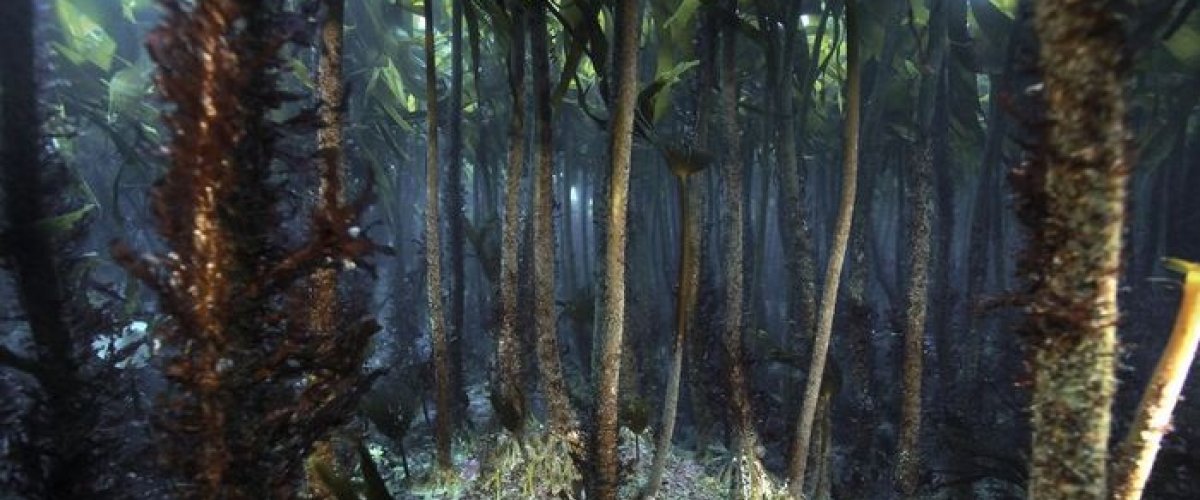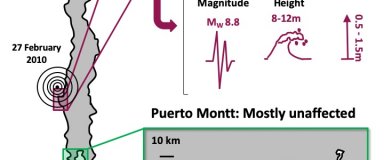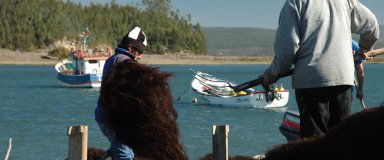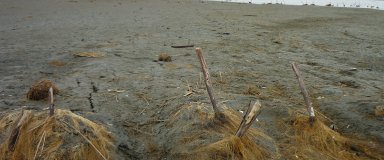


After a catastrophe, a little bit of sex is better than nothing!
Reference of the paper :
Becheler R., Guillemin M-L., Stoeckel S., Mauger S., Saunier A., Brante A. , Destombe C.& Valero M. (2020). After a catastrophe, a little bit of sex is better than nothing: Genetic consequences of a major earthquake on asexual and sexual populations. Evolutionary Applications.
We have rare opportunity to compare genetic changes and the resilience of sexual versus asexual populations before and after major natural disasters, such as tsunamis and earthquakes, due to their unpredictable nature. This study analyses the consequences of an earthquake of magnitude 8.8 on the Richter scale (February 27, 2010, in the region of Concepción in Chile) on the fate of wild and cultivated populations of the red alga Agarophyton chilense, living on impacted and unimpacted coasts of Chile.
Researchers monitored over a decade the genetic diversity of wild populations – reproducing through sexual reproduction– and cultivated populations – clonally propagated by cuttings and replanting vegetative fragments of the fronds– in two regions: Concepción near the epicentre, strongly impacted by the earthquake with deep environmental and geological changes, and Puerto Montt located 600 km to the south, unimpacted (Figure 1). Data were analysed distinguishing three sequences: before the earthquake and the tsunami of February 2010, the days which followed and two years after.
The study evidences strong disturbances in the genetic structure in the impacted area following the disaster, while no change occurred in the unimpacted region.
In the impacted area, the fully sexual wild populations experienced a loss of genetic diversity in the months that followed the earthquake. But, two years later, they recovered the level of genetic diversity they had before the disaster. Such resilience is explained by the integration of immigrants from distant sexual populations that mixed with local surviving genotypes.
On the other hand, the fate of cultivated populations shows that clonal reproduction provides a surprising capacity to buffer the instantaneous loss of diversity and mortality. But, two years later, half of the cultivated populations had disappeared and, in the survivors, genetic diversity has dropped while cultivators rescued populations by cuttings.
The contrasting fates of the sexual and asexual populations in the region close to the epicenter, suggest that betting on a strictly clonal mode of reproduction to maintain the production of algal cultures is risky in the long term despite apparent instantaneous benefits. By reducing genetic diversity to a few genotypes, this extreme strategy probably reduces the possibilities of resilience of cultivated algae to brutal environmental disturbances induced by natural disasters. That’s why integrating few sexual events in algal production should become a standard for sustainable population management.
Figure 1 modified from Fig 1 in Becheler et al. (2020) The six cultivated populations (squares) and seven wild populations (rounds) sampled before and after the earthquake and tsunami of February 27, 2010 whose epicentre was near Concepción. The populations located in the highly impacted Concepción region are in red while those in the weakly impacted Puerto Montt region are in green. The estimated magnitude of the earthquake (Richter scale) experienced at Concepción and Puerto Montt, the height of the tsunami waves and the coastal uplift values were taken from Castilla et al. (2010) and Vargas et al. (2011)
Two months after the earthquake and the uprising of several meters of land, the algae fields of the Tubul farm are decimated, a few individuals survive in the mud, in the foreground, we can see Agarophyton individuals desiccated. At the bottom, you can see a bridge destroyed by the earthquake (photo credit: C Valdovinos, Universidad de Concepción, Chile).
CONTACT
UMI 3614, Evolutionary Biology and Ecology of Algae, CNRS, Sorbonne Université, Universidad Austral de Chile, Pontificia Universidad Católica de Chile, Station Biologique de Roscoff, CS 90074, 29688 Roscoff, France
Myriam Valero : valero@sb-roscoff.fr
De par leur nature imprévisible, il est rare d’avoir l’opportunité de comparer les changements génétiques et la résilience de populations sexuées et asexuées avant et après de grandes catastrophes naturelles telles que les tsunamis et les séismes. En utilisant comme modèle d’étude, les populations sauvages et cultivées de l’algue rouge Agarophyton chilense, ces chercheurs ont étudié les conséquences du séisme du 27 Février 2010, de magnitude 8.8 sur l’échelle de Richter dans la région de Concepción au Chili. La diversité génétique des populations d’individus sauvages issus de la reproduction sexuée et des populations d’individus cultivés issus de bouturage a été suivie pendant une décennie dans deux régions : Concepción proche de l’épicentre et Puerto-Montt située à 600 km au sud. Les analyses ont ainsi été menées sur trois périodes : avant le tremblement de terre et le tsunami, les jours qui ont suivi et deux ans après. Alors qu’aucun changement n’est observé dans la région de Puerto Montt, ces travaux révèlent, dans la région de Concepción, de fortes perturbations de la structure génétique suite à la catastrophe. Immédiatement après, une perte de diversité génétique des populations sauvages (purement sexuées) est constatée par rapport aux fermes cultivées. En revanche, deux ans après, les niveaux de diversité des populations sauvages étaient revenus à ceux observés avant la catastrophe. Cette résilience des populations sauvages s’explique par le brassage des génotypes locaux survivants avec des immigrants provenant des populations sexuées éloignées.
Chez les populations cultivées, le maintien de la diversité génétique juste après la catastrophe illustre qu’un mode de reproduction clonal, confèrent aux populations des fermes une capacité surprenante à amortir la perte instantanée de diversité. Cependant, deux ans après, la moitié des populations cultivées avait disparu et dans les survivantes, la diversité génétique était fortement réduite suite au bouturage intensif des clones rescapés par les cultivateurs.
Les devenirs contrastés des populations sexuées et clonales dans la région proche de l’épicentre, suggèrent que parier sur un mode de reproduction strictement clonal pour maintenir la production des cultures est risqué à long terme malgré d’apparents bénéfices instantanés. En réduisant la diversité génétique à quelques génotypes, cette stratégie extrême diminue probablement les possibilités de résilience aux perturbations environnementales brutales induites par des catastrophes naturelles.
Figure modifiée d’après Fig 1 dans Becheler et al. (2020)
Les six populations cultivées (carrés) et sept populations sauvages (ronds) échantillonnées avant et après le séisme et le tsunami du 27 Février 2010 dont l’épicentre était proche de Concepción. Les populations situées dans la région de Concepción fortement impactée sont en rouge alors que celles de la région faiblement impactée de Puerto Montt sont en vert.
L'amplitude estimée du tremblement de terre (échelle de Richter) subie à Concepción et à Puerto Montt, la hauteur des vagues du tsunami et les valeurs de soulèvement côtier ont été tirées de Castilla et al.1 (2010) et Vargas et al.2 (2011)
1Castilla, J. C., Manríquez, P. H., & Camaño, A. (2010). Effects of rocky shore coseismic uplift and the Chilean mega-earthquake on intertidal biomarker species. Marine Ecology Progress Series, 418, 17-23.
2 Vargas, G., Farías, M., Carretier, S., Tassara, A., Baize, S., & Melnick, D. (2011). Coastal uplift and tsunami effects associated to the 2010 Mw8. 8 Maule earthquake in Central Chile. Andean Geology, 38, 219–238.
.
photo
Photo 1 ;
La collecte des individus d’Agarophyton dans la ferme de Tubul (région de Concepción) en fin d'été était une des activités principales du village avant le tremblement de terre et le tsunami de 2010 (crédit photo: M-L Guillemin, Universidad Austral de Chile, Chili).
Photo 2
Un mois après le tremblement de terre et le soulèvement de plusieurs mètres des terres, les champs d’algues de la ferme de Tubul sont décimés, quelques individus survivent dans la vase, au premier plan, on voit des individus d’Agarophyton déséchés. Au loin on peut apercevoir un pont détruit par le tremblement de terre. (crédit photo: C Valdovinos, Universidad de Concepción, Chili).
La collecte des Agarophyton dans la ferme de Tubul (région de Concepción) en fin d'été était une des activités principales du village avant le tremblement de terre et le tsunami de 2010 (credit photo: M-L Guillemin, Universidad Austral de Chile, Chili).
5 .Référence de la publication
Becheler R., Guillemin M-L., Stoeckel S., Mauger S., Saunier A., Brante A. , Destombe C.& Valero M. (2020). After a catastrophe, a little bit of sex is better than nothing: Genetic consequences of a major earthquake on asexual and sexual populations. Evolutionary Applications.
Coordonnées du laboratoire
UMI 3614, Evolutionary Biology and Ecology of Algae, CNRS, Sorbonne Université, Universidad Austral de Chile, Pontificia Universidad Católica de Chile, Station Biologique de Roscoff, CS 90074, 29688 Roscoff, France
Myriam Valero : valero@sb-roscoff.fr
Links
[1] https://www.sb-roscoff.fr/sites/www.sb-roscoff.fr/files/styles/original_image/public/fig_1_anglais.jpg?itok=l1TVLd80
[2] https://www.sb-roscoff.fr/sites/www.sb-roscoff.fr/files/styles/original_image/public/dsc_0025_0.jpg?itok=lZwQ9Dz2
[3] https://www.sb-roscoff.fr/sites/www.sb-roscoff.fr/files/styles/original_image/public/2_abril_2010.jpg?itok=7elffCSL


